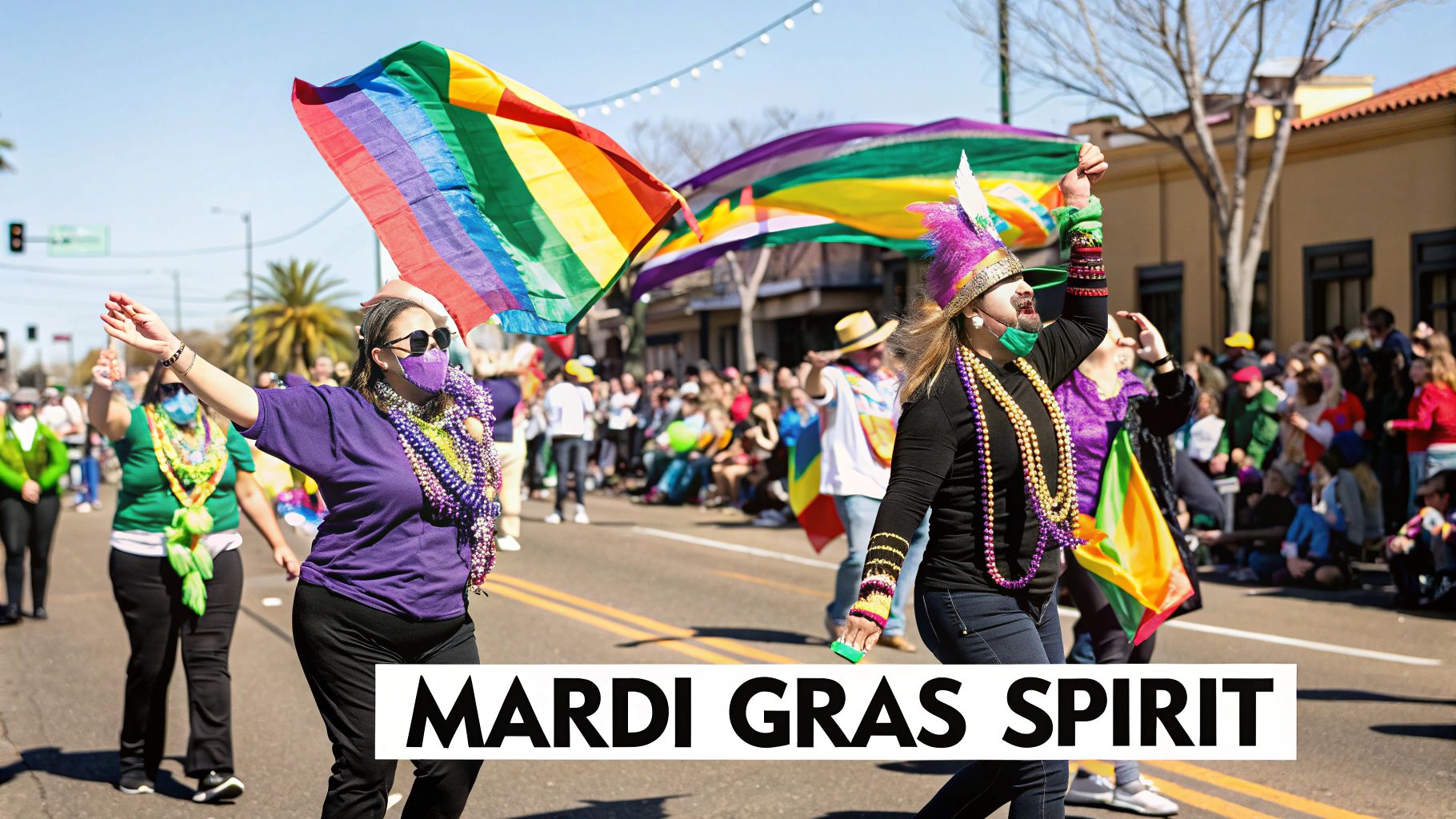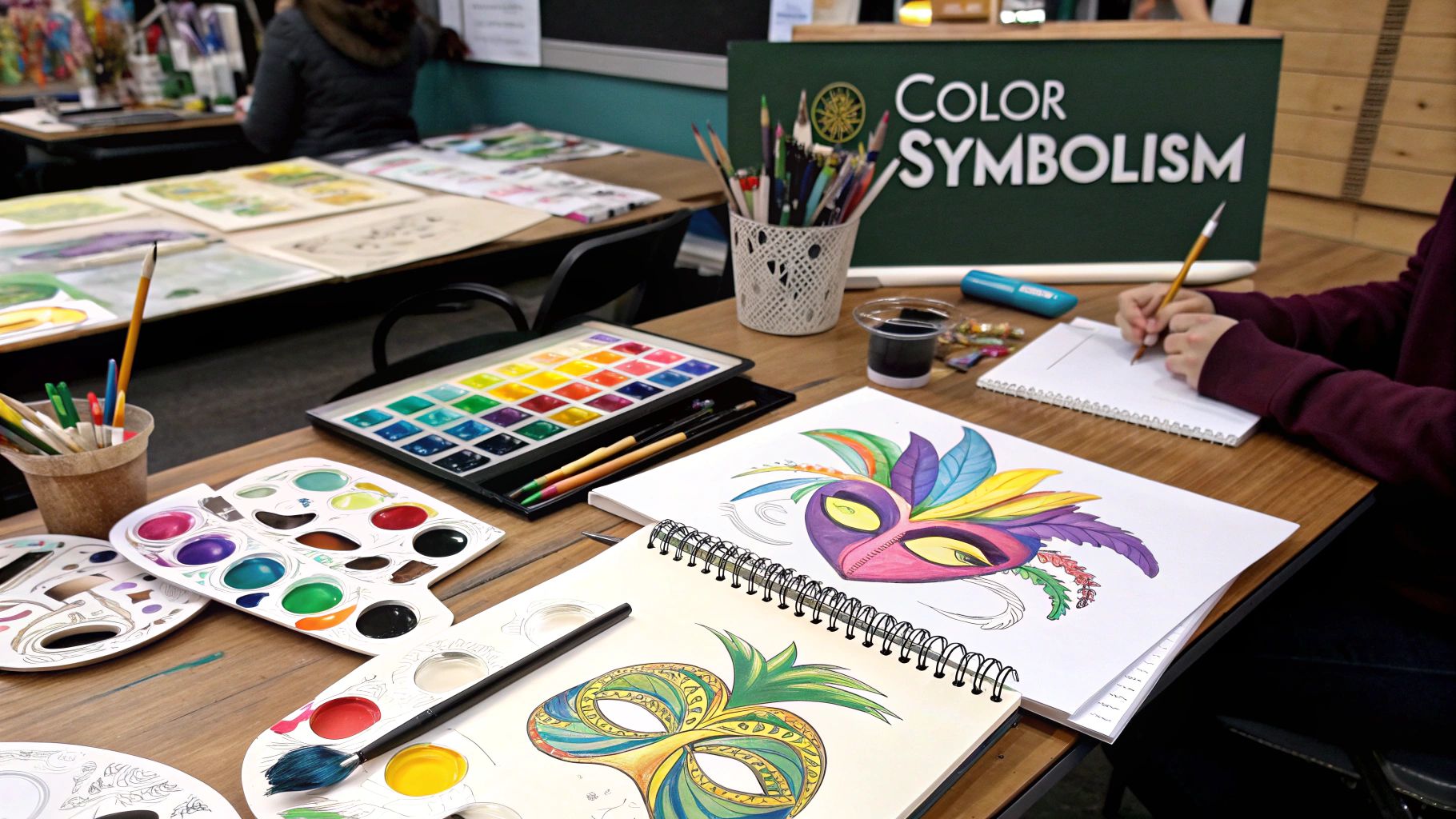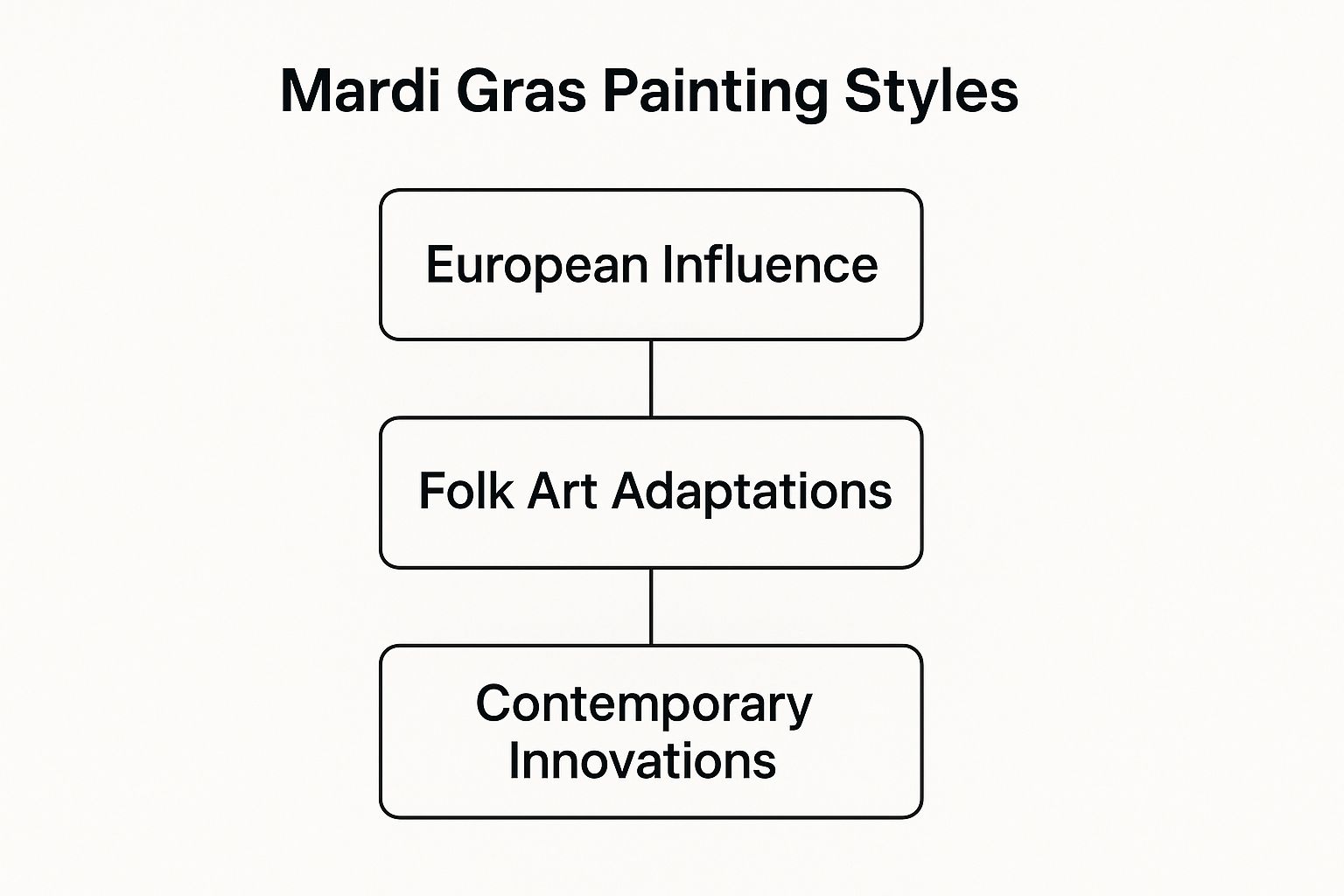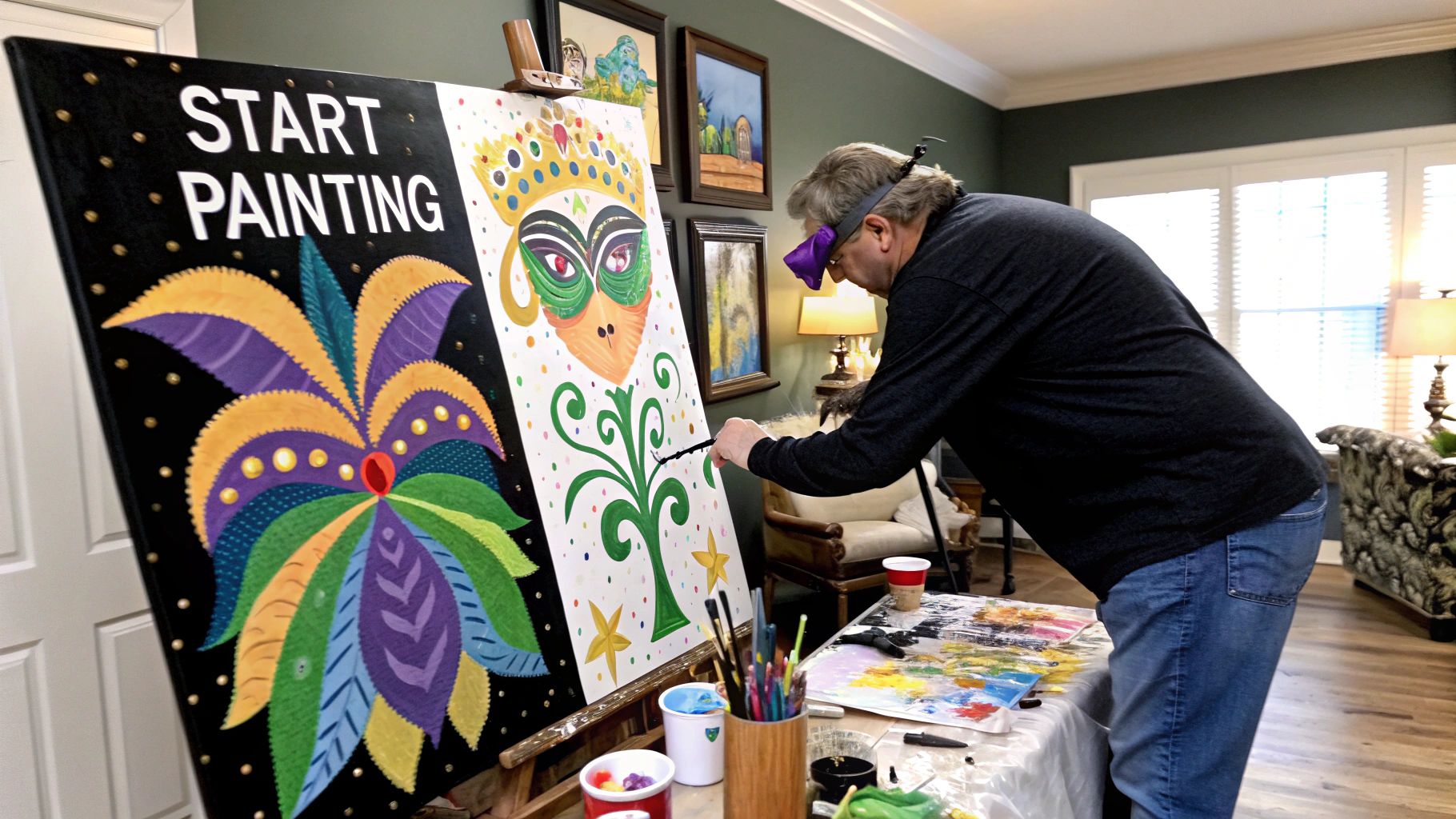Mardi Gras paintings are so much more than just pretty pictures for the wall. They’re a full-blown celebration of culture, history, and the beautiful chaos of Carnival, all captured on canvas. Using that iconic purple, green, and gold, these pieces manage to bottle up the very soul of the New Orleans experience.
What Makes Mardi Gras Paintings So Captivating?
Let’s dive into the dazzling world of Mardi Gras art. This isn't just about painting a party; it's about translating the explosive energy of the parades, the intrigue of masked revelers, and the deep-rooted traditions of the Crescent City into a visual story. Every brushstroke tells a tale, which is why these pieces become such cherished keepsakes for those who've been there and coveted works for serious art collectors.

The real pull of Mardi Gras paintings is their incredible ability to capture the kinetic energy of the festival. Artists use bold, sweeping brushstrokes and an absolute riot of color to suggest movement, noise, and excitement—so much so that you can almost hear the jazz bands and feel the buzz of Bourbon Street just by looking at one.
Capturing the Spirit of Celebration
Think of these artworks less as static images and more as visual invitations. They explore the core themes of pure joy, community, and that wonderful suspension of everyday life that truly defines the Carnival season. It’s like having a permanent ticket to the biggest, most vibrant party on Earth.
You'll often see a few key elements pop up again and again:
- The Parades: The whole spectacle is there—the incredible floats, the dedicated krewes, and the crowds of people reaching for a string of beads.
- The Symbolism: Artists love to weave in masks, bits of king cake, and the classic fleurs-de-lis, all symbols dripping with history and meaning.
- The Colors: It all comes back to that foundational palette of purple for justice, green for faith, and gold for power.
The real magic of a great Mardi Gras painting is how it makes you feel. It’s a snapshot of pure, unfiltered joy that can instantly brighten a room and lift your spirits any day of the year.
Whether the artist has created a stunningly detailed portrait of a Mardi Gras Indian or gone for a wild, abstract interpretation of the festive mood, these pieces just connect with people. They are a vibrant toast to life, art, and the one-of-a-kind spirit of New Orleans.
The Rich History Behind Carnival Art
To really understand Mardi Gras art, we have to look way back—long before the first parade rolled through the French Quarter. The story actually begins centuries ago in Europe with the wild, raucous festivals of Shrovetide, the traditional feasting days before Lent.

Even then, artists were drawn to these scenes of pure, unadulterated fun. Masters of the time painted vivid canvases filled with disguise, indulgence, and joyous crowds, creating a visual diary of the very traditions that would one day define Mardi Gras. They captured that same spirit of release and celebration we feel today.
It's fascinating to see how artists have always been compelled to document these moments of festive chaos. Think of the 17th-century Dutch painter Frans Hals and his famous piece, 'Merrymakers at Shrovetide.' It’s a perfect snapshot of the theatrical, over-the-top energy of Mardi Gras's ancestors.
From European Festivals to New Orleans Streets
When these traditions made their way across the Atlantic, they didn't come alone; they brought their vibrant visual culture with them. The core themes of masking, feasting, and parading in the streets became the beating heart of the New Orleans celebration and a goldmine of inspiration for local artists. This evolution is a huge part of the incredible story that is the art of New Orleans.
This artistic lineage creates a direct line from today's painters all the way back to the European masters. The fundamental human need for celebration hasn't really changed, even if the costumes and backdrops look a little different now.
Knowing this history completely changes how you see a modern Mardi Gras painting. You realize each new piece isn't just a pretty picture; it's part of a conversation that artists started hundreds of years ago—a celebration of life before a time of quiet reflection.
So when you see an artist painting a scene from the French Quarter today, know they’re doing more than just capturing a party. They’re taking part in a rich, historical art form, adding their own chapter to a centuries-old story of community, joy, and glorious indulgence.
Decoding the Symbols in Mardi Gras Paintings
Ever look at a painting and just know it’s about Mardi Gras? It's more than just the explosion of purple, green, and gold. What really brings these pieces to life is the rich visual language artists use—a collection of symbols that tell the story of Carnival.
When you know what to look for, each canvas becomes a vibrant narrative of culture, history, and pure, unadulterated joy.
The Parade and Its Players
So, what are these symbols? The most obvious ones come straight from the parade route. Think of those massive, elaborate floats inching down St. Charles Avenue, the masked krewe members tossing beads into a sea of outstretched hands, and the electric buzz of the crowd. Artists don't just paint a picture; they bottle that feeling of organized chaos and community spirit.
Masks are another huge element you'll see time and time again. They represent the mystique and freedom of Carnival, the chance to be someone else for a day. It's this beautiful dance between the wild public spectacle of the parade and the secretive elegance of a masquerade ball that artists love to explore.

A Visual Vocabulary
Artists often zoom in on specific icons to tell a bigger story. A quiet painting of a king cake, for instance, isn't just about dessert; it's a nod to the season's religious roots and the tradition of gathering with friends and family. A portrait of a jester might be a playful take on the "world turned upside down" theme that runs through Carnival.
To help you get the hang of it, here's a quick guide to some of the most common themes and what they're really all about.
Common Themes in Mardi Gras Art
| Theme | Common Imagery | Symbolic Meaning |
|---|---|---|
| The Parade | Floats, krewes, marching bands, crowds | Community, spectacle, tradition, public celebration |
| The Masquerade | Masks, ballgowns, hidden faces, elegant dancers | Mystery, transformation, anonymity, escapism |
| Kings & Jesters | Crowns, scepters, jester hats, motley costumes | Power and folly, social satire, the "Lord of Misrule" |
| The "Throws" | Beads, doubloons, cups, moon pies | Generosity, abundance, the ephemeral joy of the catch |
| NOLA Culture | Fleur-de-lis, street musicians, gas lamps, balconies | A deep sense of place, history, and local pride |
Recognizing these elements is like learning a new language. You start to see how every bead, doubloon, and fleur-de-lis is a piece of a much larger puzzle.
The more you can spot these symbols, the deeper your connection becomes—not just to the artwork, but to the incredible story of New Orleans itself.
How to Choose and Buy Your Perfect Piece
So, you're ready to bring a piece of the Carnival spirit home? Fantastic. Choosing art can feel like a big commitment, but finding the right Mardi Gras painting really just comes down to one thing: finding a piece that truly speaks to you.
First, let's figure out what you're really looking for. Do you crave the rich, unique texture of an original oil or acrylic painting—a one-of-a-kind creation that came directly from the artist's hands? Or would a high-quality print give you that perfect mix of vibrant beauty and a more accessible price point? Knowing the difference is your first step.
Originals Versus Prints
An original painting is exactly what it sounds like: the one and only. It’s the artist's direct vision brought to life on canvas, and for serious collectors, that uniqueness often translates to higher value.
Then you have giclée prints (you say it like zhee-KLAY). These aren't your average posters; they are incredibly high-resolution, museum-quality reproductions. Many artists even release limited edition giclées that they sign and number, turning them into valuable collectibles in their own right.
Here’s a good way to think about it: an original is like being at a live concert, feeling the raw energy in the room. A giclée is like owning a pristine, high-fidelity vinyl record of that same concert. Both are incredible ways to enjoy the art, they just offer a different experience and level of rarity.
Setting a Budget and Finding Your Style
The great news is that the world of Mardi Gras art is incredibly diverse, with something for pretty much every budget. You can find beautiful smaller works or prints for as little as $6.80 to $13.99. On the flip side, some exclusive, limited edition giclée prints can fetch up to $3,300, which shows you just how wide the spectrum is. A great place to get a feel for the market is browsing through the huge variety of Mardi Gras art on platforms like Etsy.
At the end of the day, the golden rule is simple: buy what you absolutely love. An artwork that connects with you on a personal level will bring you joy every single day, and that's the best return on investment you could ever ask for.
Don't forget to think about the artist's style. Are you more of a classic, impressionistic street scene person, or does a bold, contemporary abstract catch your eye? Part of the fun is exploring different artists and galleries, whether you're scrolling online or wandering through the French Quarter.
If you're wondering where to start, looking through curated collections of New Orleans artwork for sale is a fantastic way to discover amazing local talent. With a little looking, you’ll find the perfect piece for your home and your heart.
Styling Your Home with Festive Artwork
So, you've brought a vibrant Mardi Gras painting home. Fantastic choice! Now, how do you make this explosion of color and energy work with the rest of your decor without it feeling out of place? The trick is to let the artwork be the star of the show.
Think of it as your room's design anchor.

Instead of scrambling to find things that match perfectly, let the painting’s dynamic colors inspire your accents. See that flash of gold in the canvas? Echo it in a lamp base or a picture frame. That hint of deep purple or emerald green? That's your cue for a new throw pillow or a vase. Suddenly, the whole room feels connected and thoughtfully designed, not chaotic.
This works whether your style is sleek and modern or wonderfully eclectic. In a more neutral room, a single piece of Carnival art becomes a powerful focal point, injecting a dose of much-needed personality and fun.
Creating a Balanced Display
Where you hang the painting and how you light it can make all the difference. The biggest enemy of brilliant color is direct sunlight, which will sadly cause those amazing pigments to fade over time. Find a wall where the piece can breathe and grab attention without being washed out by the sun.
Ready to make it a true centerpiece? Here are a few ideas:
- Go Big: Don't be shy with a larger painting. Letting it dominate a wall can actually make a smaller room feel more expansive and creates an unforgettable statement.
- Gallery Wall Fun: If you have a smaller piece, don't let it get lost. Build it into a gallery wall, mixing it with personal photos, interesting mirrors, and other prints to create a display that’s uniquely you.
- Light It Up: A dedicated picture light or even a well-placed spotlight can work wonders. Highlighting your Mardi Gras paintings this way makes the colors and details pop, especially when the sun goes down.
The real goal here is to weave the joy of the artwork right into your daily life. It’s more than just hanging a picture—it’s about creating a space that makes you smile and shows off a bit of your spirit.
Ultimately, it all comes down to balance. Let the painting be the loud, life-of-the-party guest, and let your other decor be the supporting cast that helps it tell its story. When you do that, you’ll end up with a space that feels both celebratory and perfectly put-together.
Got Questions About Mardi Gras Art? We've Got Answers.
So, you're thinking about diving into the world of Mardi Gras paintings? It's a fantastic journey, but it's natural to have a few questions, whether you're buying your first piece or adding to a growing collection. Getting the right info helps you choose, care for, and truly appreciate your art.
Let's walk through some of the most common things people wonder about. Think of this as a friendly chat to clear things up, so you can feel confident and connected to the art you bring into your home.
Original Paintings vs. Giclée Prints
One of the first things people ask is, "What's the real difference between an original and a print?" It's a great question because it gets right to the heart of what makes a piece of art special.
An original painting is exactly what it sounds like—a one-of-a-kind piece, created entirely by the artist's hand. There's only one in the whole world. This uniqueness gives it the most value and a direct, tangible connection to the artist's vision.
A giclée print, on the other hand, is a very high-quality reproduction made with special inkjet technology. While they're more affordable, don't discount them! Many artists release limited edition giclées that they sign and number, and these can absolutely become valuable collectibles in their own right.
How to Care for Your Artwork
Once you’ve found a piece you love, you'll want to keep its colors looking as fresh and brilliant as the day it was painted. The good news? Proper care is pretty straightforward.
The golden rule is to keep it out of direct sunlight. UV rays are the biggest enemy of vibrant color. You'll also want to avoid places with wild temperature swings or high humidity—so, probably not the best idea to hang it in a bathroom or right over a heater.
As for keeping it clean:
- For dust: A soft, dry brush is your best friend. Just a gentle wipe is all it takes.
- For smudges: Whatever you do, never use water or chemical cleaners on an oil or acrylic painting.
- For big jobs: If your piece needs a serious cleaning or has been damaged, leave it to the pros. A professional art conservator knows exactly how to handle it.
"The best way to honor a piece of art is to preserve it. Simple steps taken today ensure that the story and vibrancy of a Mardi Gras painting can be shared for generations."
Is Carnival Art a Good Investment?
This is a tricky one. The short answer? It can be. Works by famous, well-established artists are more likely to go up in value over time. But honestly, most people collect this art because it speaks to them on a personal, cultural level.
My best advice is always the same: buy what you love. If a painting catches your eye and brings you joy every time you see it, it has already paid for itself. If it happens to appreciate in value down the road, think of it as a happy bonus.
And what about those signature colors? That classic trio of purple, green, and gold was officially chosen by the Krewe of Rex way back in 1872. In art, just like in the parades, purple stands for justice, green for faith, and gold for power. It’s amazing how artists can use just those three colors to capture the entire soul of Carnival.
Ready to find your own piece of New Orleans magic? Take a look through the incredible collections at William Tucker Art. You might just find the perfect painting to bring that festive spirit right into your home at https://williamtuckerart.com.
